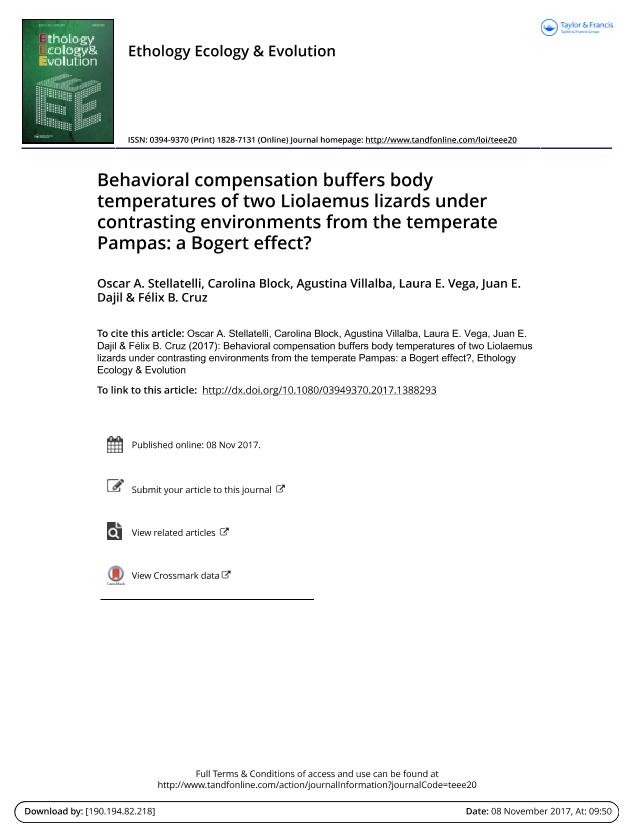Mostrar el registro sencillo del ítem
dc.contributor.author
Stellatelli, Oscar Aníbal

dc.contributor.author
Block, Carolina

dc.contributor.author
Villalba, Agustina

dc.contributor.author
Vega, Laura Estela

dc.contributor.author
Dajil, Juan Esteban
dc.contributor.author
Cruz, Felix Benjamin

dc.date.available
2018-08-17T17:18:31Z
dc.date.issued
2018-07
dc.identifier.citation
Stellatelli, Oscar Aníbal; Block, Carolina; Villalba, Agustina; Vega, Laura Estela; Dajil, Juan Esteban; et al.; Behavioral compensation buffers body temperatures of two Liolaemus lizards under contrasting environments from the temperate Pampas: a Bogert effect?; Universita Degli Studi Di Firenze; Ethology Ecology & Evolution; 30; 4; 7-2018; 297-318
dc.identifier.issn
0394-9370
dc.identifier.uri
http://hdl.handle.net/11336/56191
dc.description.abstract
Postural adjustments and microhabitat selection are two behavioral mechanisms that lizards extensively use to regulate their body temperatures. The Bogert effect occurs when behavioral thermoregulation buffers potential changes in body temperatures of congeneric organisms due to environmental variation, in turn precluding physiological evolution. We compared field body temperatures (Tb) and behavioral thermoregulation traits between two Liolaemus lizards: the saxicolous Liolaemus tandiliensis and the arenicolous Liolaemus wiegmannii. These species are spatially segregated in two thermally contrasting environments from the SE of the temperate Pampas of Argentina. During summer, the mean operative temperature (Te) of the coastal sand dunes occupied by L. wiegmannii was 9 ºC higher than that of the Tandilia mountains inhabited by L. tandiliensis. Despite the contrasting thermal conditions of both habitats, the mean Tb of L. tandiliensis (34.72 °C) was similar to that of L. wiegmannii (35.01 °C). The behavioral thermoregulation mechanisms varied considerably between both species. Liolaemus tandiliensis combined static body posture with displacements towards sunlit areas. In contrast, L. wiegmannii combined elevated and prostrated body postures with movements towards full and filtered sun patches. Environmental gradients offer diverse challenges impelling lizards to find different behavioral thermoregulation adaptations in order to partially cope with environmental constraints. This occurs in many species of Liolaemus that are thermoregulatory efficient despite of the climatic adversities. In this study, two species of Liolaemus used different postural and microhabitat path-selection strategies according to climate, allowing them to buffer changes in Tb, thus suggesting that the Bogert effect may be occurring in these two species.
dc.format
application/pdf
dc.language.iso
eng
dc.publisher
Universita Degli Studi Di Firenze

dc.rights
info:eu-repo/semantics/openAccess
dc.rights.uri
https://creativecommons.org/licenses/by-nc-sa/2.5/ar/
dc.subject
Behavior
dc.subject
Liolaemus
dc.subject
Reptiles
dc.subject
Temperate Climate
dc.subject
Thermoregulation
dc.subject.classification
Otras Ciencias Biológicas

dc.subject.classification
Ciencias Biológicas

dc.subject.classification
CIENCIAS NATURALES Y EXACTAS

dc.subject.classification
Otras Ciencias Biológicas

dc.subject.classification
Ciencias Biológicas

dc.subject.classification
CIENCIAS NATURALES Y EXACTAS

dc.title
Behavioral compensation buffers body temperatures of two Liolaemus lizards under contrasting environments from the temperate Pampas: a Bogert effect?
dc.type
info:eu-repo/semantics/article
dc.type
info:ar-repo/semantics/artículo
dc.type
info:eu-repo/semantics/publishedVersion
dc.date.updated
2018-07-23T17:59:46Z
dc.journal.volume
30
dc.journal.number
4
dc.journal.pagination
297-318
dc.journal.pais
Italia

dc.journal.ciudad
Florencia
dc.description.fil
Fil: Stellatelli, Oscar Aníbal. Consejo Nacional de Investigaciones Científicas y Técnicas. Centro Científico Tecnológico Conicet - Mar del Plata. Instituto de Investigaciones Marinas y Costeras. Universidad Nacional de Mar del Plata. Facultad de Ciencia Exactas y Naturales. Instituto de Investigaciones Marinas y Costeras; Argentina
dc.description.fil
Fil: Block, Carolina. Consejo Nacional de Investigaciones Científicas y Técnicas. Centro Científico Tecnológico Conicet - Mar del Plata. Instituto de Investigaciones Marinas y Costeras. Universidad Nacional de Mar del Plata. Facultad de Ciencia Exactas y Naturales. Instituto de Investigaciones Marinas y Costeras; Argentina
dc.description.fil
Fil: Villalba, Agustina. Consejo Nacional de Investigaciones Científicas y Técnicas; Argentina. Universidad Nacional de Mar del Plata. Facultad de Ciencias Exactas y Naturales; Argentina
dc.description.fil
Fil: Vega, Laura Estela. Consejo Nacional de Investigaciones Científicas y Técnicas. Centro Científico Tecnológico Conicet - Mar del Plata. Instituto de Investigaciones Marinas y Costeras. Universidad Nacional de Mar del Plata. Facultad de Ciencia Exactas y Naturales. Instituto de Investigaciones Marinas y Costeras; Argentina
dc.description.fil
Fil: Dajil, Juan Esteban. Consejo Nacional de Investigaciones Científicas y Técnicas. Centro Científico Tecnológico Conicet - Mar del Plata. Instituto de Investigaciones Marinas y Costeras. Universidad Nacional de Mar del Plata. Facultad de Ciencia Exactas y Naturales. Instituto de Investigaciones Marinas y Costeras; Argentina
dc.description.fil
Fil: Cruz, Felix Benjamin. Consejo Nacional de Investigaciones Científicas y Técnicas. Centro Científico Tecnológico Conicet - Patagonia Norte. Instituto de Investigaciones en Biodiversidad y Medioambiente. Universidad Nacional del Comahue. Centro Regional Universidad Bariloche. Instituto de Investigaciones en Biodiversidad y Medioambiente; Argentina
dc.journal.title
Ethology Ecology & Evolution

dc.relation.alternativeid
info:eu-repo/semantics/altIdentifier/doi/https://dx.doi.org/10.1080/03949370.2017.1388293
dc.relation.alternativeid
info:eu-repo/semantics/altIdentifier/url/https://www.tandfonline.com/doi/full/10.1080/03949370.2017.1388293
Archivos asociados
